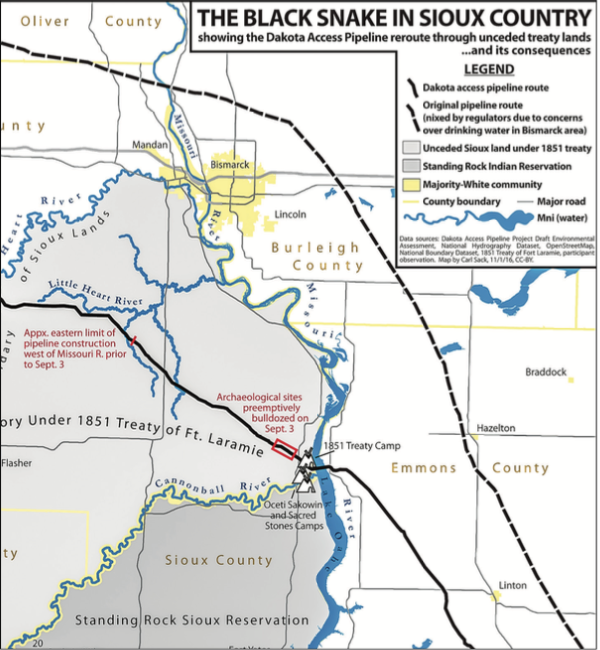The Energy Transfer Partners project resumes with new administration

PLAN — Construction on the Dakota Access Pipeline was haulted under former President Barack Obama.
GOOGLE IMAGE
After a five-month delay, construction on the Dakota Access Pipeline (DAPL) has resumed at Lake Oahe marking the end of months of protest and a failure on the part of the government to enforce the law and by the media to prevent the spread
of misinformation.
Since Aug. 15, 2016 protestors have prevented the lawful completion of the pipeline while costing Energy Transfer Partners (ETP), the Texas-based company building the DAPL, millions in damage to construction equipment.
Their protest was launched in the name of protecting the rights of Native Americans and the environment — the problem is many of these protestors and members of the public have been misled.
The DAPL does not violate the rights of Native Americans nor does it intend to desecrate their tribal land.
In planning the pipeline, ETP had more than 550 meetings with community, business and Native American Tribal leaders, changing the route more than 140 times in order to avoid historically and culturally significant areas.
Additionally, 99.8 percent of the pipeline is being constructed on privately owned land while the remainder is federally owned, namely the Lake Oahe crossing.
When the Army Corps of Engineers approved the pipeline’s plan to cross Lake Oahe and the Missouri river July 25, 2016, their 1,261-page report noted that no significant historical sites would be affected by the pipeline’s construction.
Part of the Corps’ review process included a public comment period spanning more than five months, and their report noted no significant concerns raised during the comment period had been left unresolved.
However, 10 days after the pipeline was approved, the Standing Rock Sioux tribe sued the U.S. Army Corps of Engineers on the claim that they failed to consult the tribe members, violating the Corps responsibility “to ensure against destruction of culturally important sites.”
This lawsuit was dismissed by U.S. District Judge James Boasberg as he determined the Army Corps met its obligation to consult the tribe.
He also noted the tribe failed to show that the pipeline would cause them any injury as the crossing takes place on federal land, not tribal land.
However, the attention attracted by protestors led the Obama administration’s justice department to ignore this ruling and pressure the Army Corp to delay construction of the pipeline pending a new investigation, comment period and environmental impact report.
Claims that the pipeline will threaten the environment were based more on an anti-oil platform than facts. Pipelines have been shown to be a safer and more environmentally friendly means of transporting oil compared to rail or trucking alternatives in several studies, including one conducted by the Fraser Institute in 2013.
ETP has noted the positive environmental impact this pipeline will have as it has the potential to remove 250 oil trucks from the road.
They also claim that the design and plan for pipeline will make it one of the safest in the country.
Currently, the Department of Transportation’s Pipeline and Hazardous Materials Safety Administration requires that pipelines under waterways must be at least four feet below the riverbed.
The existing pipelines under Lake Oahe are buried around 15 feet below the surface in a layer of what is predominantly sand and gravel.
ETP, on the other hand, plans to have the pipeline run at least 95 feet below the lake floor, drilling through clay and shale layers to ensure that if a leak should form in the future, the oil will not contaminate the water.
ETP has also exceeded its responsibility to prevent potential leaks as the pipeline is being constructed of steel pipes that are 50 percent thicker than required by law.
The oil flowing through the pipeline will also be monitored 24/7 so any leaks that do occur can be identified and repaired quickly.
ETP exceeded all its legal requirements only to find the Obama administration changed the rules of the game.
“John Marshal has made his decision; now let him enforce it.”
This statement was made by President Andrew Jackson following the Supreme Court decision that the State of Georgia could not seize Native American’s tribal lands.
Now, almost 200 years later, another president has ignored the decision of the judicial branch as the Obama administration failed to uphold the law in a consistent and fair manner.
While a dramatic comparison, it should be a reminder of what happens when the checks and balances of government fail.
Following the inauguration of President Donald Trump, the Army Corps was instructed to expedite its re-review and approval process for the pipeline.
Now, with construction having resumed and the pipeline’s completion anticipated in the next few months, it is possible that our country is at last on track to return to
the rule of law.